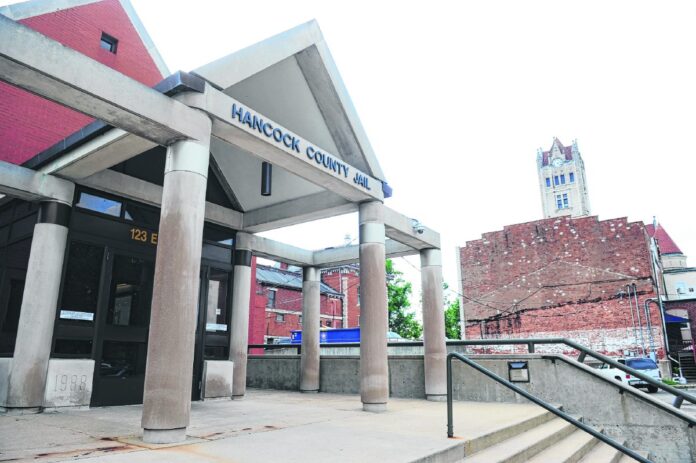HANCOCK COUNTY — The county is spending about $8,000 to make renovations at the jail in order to make sure the coronavirus, if brought into the facility by an inmate, doesn’t spread.
Sheriff Brad Burkhart and jail commander Bridget Foy have worked to prevent COVID-19, the illness caused by the novel coronavirus, from entering the jail and spreading. They are following guidelines for correctional facilities from the Centers for Disease Control and Prevention. Those guidelines include limiting the number of arrests, a practice that has been under way for several weeks. Also, the courts are decreasing the number of inmates by letting some out of jail early or reducing their bonds.
As of Monday, the jail population was down to 149 inmates, which is actually below its capacity of 157 beds. Over the past 13 days, only five people have been booked into the jail.
Population regularly was over 225 inmates before the pandemic.
Still, Burkhart wanted to do more and approved plans to create a holding area for all new inmates to be housed for 14 days, giving officials a chance to be certain new inmates are not infectious. After the quarantine time elapses, the new inmate can then be transferred into the general population.
The remodeling took place in the A-B block area in the A portion that has six cells. Workers had to rework the air flow handlers because certain blocks were connected and air flowed throughout all the areas, Burkhart said.
The goal was to create a holding block with its own airflow. The renovation gives the jail an area that can be used to separate certain prisoners.
All new inmates are under a “routine quarantine” based on CDC recommendations, Burkhart said.
“That’s whether you come from another facility or off the street, we’ve got to quarantine because we don’t know their status,” Buckhart said.
He added: “If we’ve got one person coming here for even three or four days from another facility, and they suddenly become symptomatic and are in the general population, you’ve got a contamination on hand. We just can’t have that.”
On Friday, Gov. Eric Holcomb, Chief Justice Loretta Rush and legislative leaders encouraged counties to take measures to reduce jail populations after the American Civil Liberties Union filed a petition for the release of some prisoners.
“Given the unique threat posed by COVID-19, we encourage every community that is or will be undertaking a process to evaluate whether to release juveniles and inmates, to do so in a responsible and humane manner,” the state government letter said. “They should review the current facility population to properly identify which low-risk, non-violent juveniles and inmates, if any, may be re-evaluated and released safely into their communities under pretrial, probation or community corrections supervision.”
Hancock County officials already had taken steps to reduce the jail population, consulting with the prosecutor’s office “to have those conversations about those low-level offenders whose out-dates were drawing near,” Foy said.
They’ve been able to release several inmates who were scheduled to be released before April 30. Now, they are going to submit a new list of low-level candidates who have out-dates beyond the end of the month to see if they can lower the count even more.
“The strategy of releasing the low level offenders whose out-dates are drawing near is nothing new and is being done throughout the country in order to limit the close quarter contact that inmates have with one another,” Foy said.
Because COVID-19 can present no symptoms, jailers must be cautious introducing any new inmates into the general population. Decreasing the population helps, Foy said, but so does keeping the new inmates separated for at least 14 days. Jailers can’t afford to have one person in the facility come down with the virus.
Until maintenance workers could change the ventilation permanently and create an isolated holding cell, the county was housing new inmates in the rec-room area, which was made into a negative airflow room. While the temporary holding area had no running water, inmates had access to a call button so they could get water to drink, wash their hands or take a restroom break.
Burkhart hopes the reconfigured cell block will be a better arrangement.
“Nobody planned for anything like this,” he said. “We’re doing the best we can do.”





